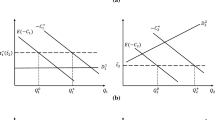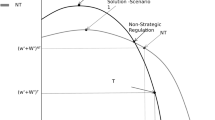Abstract
This paper provides an answer to the question: Are emission taxes an efficient and self-enforcing mechanism to control correlated externality problems? By “correlated externalities” we mean multiple pollutants that are jointly produced by a single source but cause differentiated regional and global externalities. By “self-enforcing” we mean a mechanism that accounts for the endogeneity that exists between competing jurisdictions in the setting of environmental policy within a federation of regions. This mechanism incorporates sequential decision making among the jurisdictions and therefore determines an equilibrium based on the concept of subgame perfection. We find that, unlike joint domestic and international tradable permit markets, joint emission taxes and a hybrid scheme of permits and taxes are neither efficient nor self-enforcing.
Similar content being viewed by others
References
Barrett S. (1994). Self-Enforcing International Environmental Agreements. Oxford Economic Papers 46: 878–894
Brauer H. and Varma Y. B. G. (1981). Air Pollution Control Equipment. Springer-Verlag, New York
Caplan A. J. and Silva E. C. D (2005a). An Efficient Mechanism to Control Correlated Externalities: Redistributive Transfers and the Coexistence of Regional and Global Pollution Permit Markets. Journal of Environmental Economics and Management 49(1): 68–82
Caplan, A. J. and E. C. D. Silva (2005b), ‘An Equitable, Efficient, and Implementable Scheme to Control Global Carbon Dioxide Emissions’, Economic Research Institute Working Paper 2002-22, Utah State University
Carraro C. and Siniscalco D. (1993). Strategies for the International Protection of the Environment. Journal of Public Economics 52: 309–328
Chichilnisky G., Heal G. and Starrett D. (2000). Equity and Efficiency in Environmental Markets: Global Trade in Carbon Dioxide Emissions. In: Chilchinisky, G. and Heal, G. (eds) Environmental Markets: Equity and Efficiency, pp. Columbia University Press, New York
Finus, M. (2004), ‘Modesty Pays: Sometimes!’ Working Paper 68.04, Fondazione Eni Enrico Mattei (FEEM)
Finus, M., J. C. Altamirano-Cabrera and E. van Ierland (2004), ‘The Effect of Membership Rules and Voting Schemes for the Success of International Climate Agreements’, Public Choice, forthcoming
Hoel M. (1992). Carbon Taxes: An International Tax or Harmonized Domestic Taxes?. European Economic Review 36: 400–406
Laffont J.-J. (1977). More on Prices vs. Quantities. Review of Economic Studies 44: 177–186
Lerner A. (1971). The 1971 Report of the President’s Council of Economic Advisors: Priorities and Efficiency. American Economic Review 61: 527–530
Michaelis P. (1992). Global Warming: Efficient Policies in the Case of Multiple Pollutants. Environmental and Resource Economics 2: 61–77
Milliman S. R. and Prince R. (1989). Firm Incentives to Promote Technological Change in Pollution Control. Journal of Environmental Economics and Management 17: 247–265
Roberts M. J. and Spence M. (1976). Effluent Charges and Licenses Under Uncertainty. Journal of Public Economics 5: 193–208
Shrestha R. K. (2001). The Choice of Environmental Policy Instruments under Correlated Uncertainty. Resource and Energy Economics 23(2): 175–185
Stavins R. N. (1996). Correlated Uncertainty and Policy Instrument Choice. Journal of Environmental Economics and Management 30(2): 218–232
Theodore L. and Buonicore A. J. (1982). Air Pollution Control Equipment: Selection, Design, Operation and Maintenance. Prentice-Hall, Englewood Cliffs
Weitzman M. (1974). Prices vs. Quantities. Review of Economic Studies 41: 477–491
Weitzman M. (1978). Optimal Rewards for Economic Regulation. American Economic Review 68: 683–691
Author information
Authors and Affiliations
Corresponding author
Rights and permissions
About this article
Cite this article
Caplan, A.J. A Comparison of Emission Taxes and Permit Markets for Controlling Correlated Externalities. Environ Resource Econ 34, 471–492 (2006). https://doi.org/10.1007/s10640-006-0010-3
Accepted:
Published:
Issue Date:
DOI: https://doi.org/10.1007/s10640-006-0010-3




